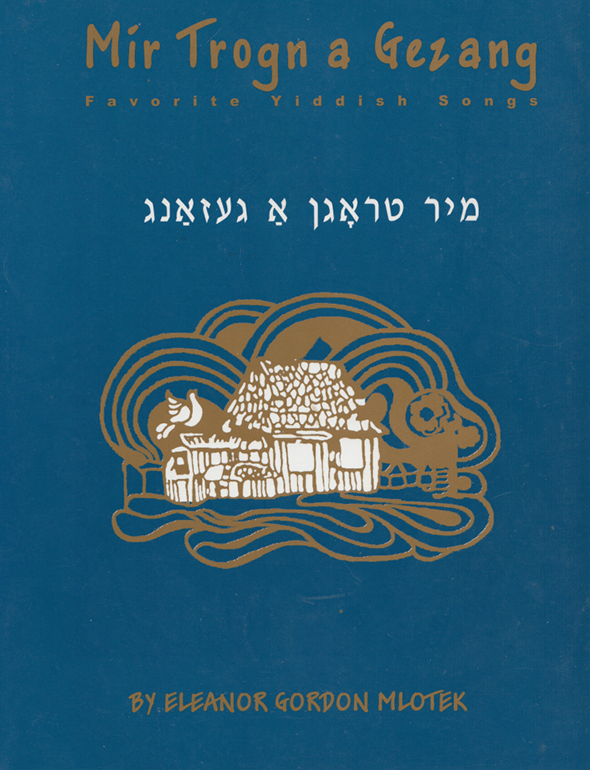Poem by Hirsh Glik (1922-1944), music by Dmitri Pokrass. The song became the hymn of the United Partisan Organization in 1943. It spread to all the camps in Eastern Europe and later to all Jewish communities the world over. It was translated into several languages. Today it is sung at memorial meetings for martyred Jews. Published by Yehude Ayzman in 1945.

Never say that you are going your last way,
Though lead-filled skies above blot out the blue of day.
The hour for which we long will certainly appear,
The earth shall thunder ‘neath our tread that we are here!
From lands of green palm trees to lands all white with snow,
We are coming with our pain and with our woe,
And where’er a spurt of our blood did drop,
Our courage will again sprout from that spot.
For us the morning sun will radiate the day,
And the enemy and past will fade away,
But should the dawn delay or sunrise wait too long,
Then let all future generations sing this song.
This song was written with our blood and not with lead,
This is no song of free birds flying overhead,
But a people amid crumbling walls did stand,
They stood and sang this song with rifles held in hand.
(Translated by Elliot Palevsky)
Zog nit keyn mol az du geyst dem letstn veg,
Khotsh himlen blayene farshteln bloye teg.
Kumen vet nokh undzer oysgebenkte sho —
S’vet a poyk ton undzer trot — mir zaynen do!
Fun grinem palmenland biz vaysn land fun shney,
Mir kumen on mit undzer payn, mit undzer vey,
Un vu gefaln s’iz a shprits fun undzer blut,
Shprotsn vet dort undzer gvure, undzer mut.
S’vet di morgnzun bagildn undz dem haynt,
Un der nekhtn vet farshvindn mitn faynd,
Nor oyb farzamen vet di zun in dem kayor —
Vi a parol zol geyn dos lid fun dor tsu dor.
Dos lid geshribn iz mit blut un nit mit blay,
S’iz nit keyn lidl fun a foygl af der fray,
Dos hot a folk tsvishn falndike vent
Dos lid gezungen mit naganes in di hent!
To zog nit keyn mol az du geyst dem letstn veg,
Khotsh himlen blayene farshteln bloye teg.
Kumen vet nokh undzer oysgebenkte sho —
S’vet a poyk ton undzer trot — mir zaynen do!
זאָג ניט קײן מאָל אַז דו גײסט דעס לעצטן װעג,
כאָטש הימלען בלײַענע פֿאַרשטעלן בלױע טעג,
קומען װעט נאַך אונדזער אױסגעבענקטע שעה -–
ס’װעט אַ פּױק טאַן אונדזער טראָט — מיר זײנען דאַ!
פֿון גרינעם פּאַלמענלאַנד ביז װײַסן לאַנד פֿון שנײ,
מיר קומען אָן מיט אונדזער פּײַן, מיט אונדזער װײ,
ֶאון װוּ געפֿאַלן ס’איז אַ שפּריץ פֿון אונדזער בלוט,
שפּראָצן װעט דאָרט אונדזער גבֿורה, אונדזער מוט.
ס’װעט די מאָרגנזון באַגילדן אונדז דעם הײַנט,
און דער נעכטן װעט פֿאַרשװינדן מיטן פֿײַנד,
נאָר אױב פֿאַרזאַמען װעט די זון אין דעם קאַיאָר —
װי אַ פּאַראָל זאָל גײן דאָס ליד פֿון דור צו דור.
דאָס ליד געשריבן איז מיט בלוט און ניט מיט בלײַ,
ס’איז ניט קײן לידל פֿון אַ פֿױגל אױף דער פֿרײַ,
דאָס האָט א פֿאָלק צװישן פֿאַלנדיקע װענט
דאָס ליד געזונגען מיט נאַגאַנעס אין די הענט!
טאָ זאָג ניט קײן מאָל אַז דו גײסט דעם לעצטן װעג,
כאָטש הימלען בלײַענע פֿאַרשטעלן בלױע טעג,
קומען װעט נאָך אונדזער אױסגעבענקטע שעה —
ס’װעט אַ פּױק טאָן אונדזער טראָט — מיר זײַנען דאָ!
Song Title: Zog Nit Keyn Mol!

First published in 1972, Mir Trogn A Gezang: Favorite Yiddish Songs was reprinted six more times (in 1977, 1982, 1985, 1987, 1988, 2000) due to popular demand. The songs in this anthology represent a sampling of beloved folk and well-known Yiddish songs, many of which are scattered in various song collections; some appear in very rare and inaccessible collections; and some were never before published. Folk songs comprise about a third of this volume and were selected mainly on the basis of popularity and sometimes for their historic significance. Needless to say, they are only representative of the vast, rich treasure of Yiddish folk material. The selection was made not only on the basis of personal preference, but in the knowledge they are favorites of many who sing these songs. Most of the songs represent the repertoire that was sung at Yiddish summer camps, May 1st demonstrations and at social gatherings. Many songs were introduced to American Jewry by Jewish immigrants who came to the United States after World War II, for whom these songs had been favorites in Poland and other East European communities destroyed by the Nazis.